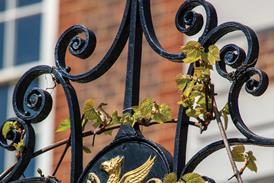In the mid-1970s Monty Python ran an Australian wine-tasting sketch with the punchline ‘bring your own bottle’. The studio audience cried with laughter. With names such as Kanga Rouge and Wallaby White just starting to appear on the British High Street, it was little wonder that its then fledgling wine industry was regarded by many as a joke. Thirty years later, Australia vies with France for the number one slot in UK wine sales. Who’s laughing now?
Nobody is suggesting that by 2040 our supermarkets will be overflowing with English wine, but there is a growing feeling that after years of propping up tables at garden fêtes and obscure agricultural shows, English wine is ready to step into the limelight. The seeds were sown a few years ago when a blind tasting organised by Which? magazine showed that three English sparkling wines were judged to be better than champagne. A spate of positive headlines followed, delighting in the fact that it was now better than its French counterpart. The industry received a further fillip when it emerged that Frazer Thompson, of Chapel Down Wines in Kent, was in active discussions with a major champagne house to sell some land. Wine writers, however, were not surprised, since champagne houses have always looked overseas to expand their empires. Moët & Chandon started the trend back in the 1950s when it invested heavily in Argentina and California.
In Champagne, at least, the threat from medal-winning English producers such as Nyetimber, Denbies, Camel Valley, Chapel Down and Ridgeview is taken very seriously. As one leading executive from a well-known champagne house recently said to me: ‘A number of houses are actively looking in England at the moment. It will not be long before we see an acquisition, perhaps then the world will have finally woken up to the quality of English wine.’
What has attracted the French is the standard of chardonnay, pinot noir and pinot meunier achieved in England. Many put this down to the fact that the two regions share similar conditions – both sit on the same chalky limestone escarpment. Indeed, driving through Champagne’s Marne valley the similarity with England’s rolling South Downs is marked.
Quality has also been helped by an outstanding run of vintages, including the heat wave of 2003, which has produced a crop of grapes enabling the production of highly aromatic, light, racy sparkling wine. These are the ones that are grabbing all the attention – not the red wines or the majority of still whites, which are interesting but often too expensive to compete with their international counterparts.
Wine production in England is still a cottage industry, with around 3,000 acres under vine in England and Wales. The recent flurry of publicity has seen the number of vineyards swell to more than 370, with 20 being planted in 2007 and more planned for this year. Kent, Sussex and Hampshire are the main wine-growing regions, but as sparkling wine expert Tom Stevenson points out, many of the best sites may already have gone, lost to over-enthusiastic property developers.
Leading the pack is undoubtedly Nyetimber. It is nearly 20 years since this Sussex-based winery produced its first batch of sparkling wine. Since then it has consistently cleaned up at the International Wine and Spirit Awards, and won the approval of the Queen, who served it at her golden wedding celebrations, and Tony Blair, who served it at the golden jubilee dinner at Downing Street. It has even earned itself a listing among some of the best champagne in the world at Berry Bros & Rudd.
This year, the English Wine Producers annual tasting was held at Lord’s cricket ground. With availability improved, Waitrose and Marks & Spencer both now take the category seriously – I thought it was about time I made the effort to go.
The tasting was shrouded in understatement. Despite picking up a swathe of awards, a gentle air of amazement still surrounds the industry. In short, the sparkling wines I tasted were good. The fruit is lively, floral and attractive, but sometimes they lack a bit of character on the palate. Personally, I wouldn’t say they have reached the quality of champagne. But then again, the Champenois have had a 500-year head start.
Nyetimber was undoubtedly one of the stars of the tasting, but at £25-£28 a bottle it is not cheap. When you pitch yourself above Pol Roger White Foil (£27.95), you have to be very good indeed. I was also impressed with the tart, flowery, grassy 2006 Three Choirs Stone Brook (£5.95 at The Wine Society).
Where I think a marketable niche can be achieved is with wines such as Three Choirs' excellent Classic Cuvée, which is delicate and floral, with a pleasant, refreshing acidity and a rounded savoury mouth-feel – and which comes in at just £10.25 a bottle. I’m intending to serve it at a sizeable drinks party I am hosting this summer. I suspect nobody will laugh.
Will Lyons is wine correspondent of Scotland on Sunday newspaper
- WINE WATCHWines of the week
Three Choirs Classic Cuvée, Newent, GloucestershireA blend of 80% seyval blanc and 20% pinot noir, this has the dry, savoury kick necessary for good sparkling wine. It is floral on the nose, with a delicate, thrilling acidity, and at this price, it ticks all the right boxes.£10.25•••••••
2001 Nyetimber Classic Cuvée, West Chiltington, West SussexThis blend of chardonnay, pinot noir and pinot meunier is even richer than the more famous blanc de blancs, but somehow retains its freshness. It has red fruit on the nose and a clean finish.£25•••••••
2004 Chapel Down Sparkling English Rosé, Tenterden, KentA charming wine that evokes memories of long, hot English summer days. An attractive nose with floral notes of wild strawberries, citrus and redcurrants. The palate is dry with good ripeness. £20••••••
Stockists: Waitrose, Tesco, Sainsbury’s, Majestic, Harvey Nichols



























No comments yet